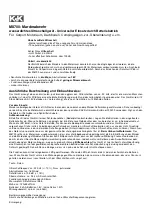
15
l
Inspect top cover for signs of damage or wear which could result in the contamination
of the interior, e.g. tears, holes, damage to seams or zips, underside staining, etc. The
frequency of these checks should be between patients or patient occupancy (weekly for
longer term patients).
l
Care should be taken to avoid puncturing cover with objects such as needles, scalpels,
pat slides, acrylic nails, etc.
l
The cover may be removed and cleaned in accordance with The Revised Healthcare
Cleaning Manual June 2009 subject to the following action: Following the use of a
detergent and or disinfectant solution the mattress cover should be rinsed with clean
water using a clean cloth and allowed to dry.
l
Frequent or prolonged exposure to high concentrations of aggressive disinfectant
solutions will reduce the useful life of the mattress/cushion cover.
l
Where high concentration disinfectants e.g. > 10,000ppm chlorine releasing agent
(e.g. Haztab or bleach) or combined cleaning/chlorine releasing agent (e.g. Chlorcleam,
Actichlor) and detergent solutions are used to remove blood or other body fluids,
mattresses/cushions should be thoroughly rinsed with clean water to remove any
residues. This will help prevent any possible long term compatibility issues associated
with disinfectant residues.*
l
Alternatively disinfection may be achieved by laundering at temperatures not exceeding
65
0
C for 10 minutes or 73
0
C for 3 minutes which may include a chlorine rinse.
l
Do not use abrasive cleaners, phenol disinfectants, solvents or alcohol-based cleansers,
e.g. Dettol, Phenicol, Hibiscrub, Clearsol, Stericol, Hycoline as these may destroy the
cover materials.
l
Do not iron.
l
Ensure that the mattress/cushion is thoroughly dried before remaking the bed or placing
in storage.
INTERIOR
l
Inspect the mattress/cushion interior for signs of damage or contamination, e.g.
staining or evidence of fluid ingress. The frequency of these checks should be at each
decontamination process, i.e. between patients or patient occupancy (or weekly for
longer term patients)
l
Contaminated mattresses/cushions should be removed from service and disposed of in
accordance with local policy.
l
Regular turning will prolong the life of the mattress. The POLYFLOAT DORMIRA™ /
POLYFLOAT SUPREMA™ mattress has a 2 way turning cycle. Please refer to instructions
printed on cover.
SYSTEM DESIGN LIFE:
3 years
HANDLING AND STORAGE
Handle with care. Please report instances of damage or impact to Talley Service Department.
The mattress should be stored flat.
Temperature: Operational: 10
0
C to 40
0
C
Storage: 10
0
C to 55
0
C





































